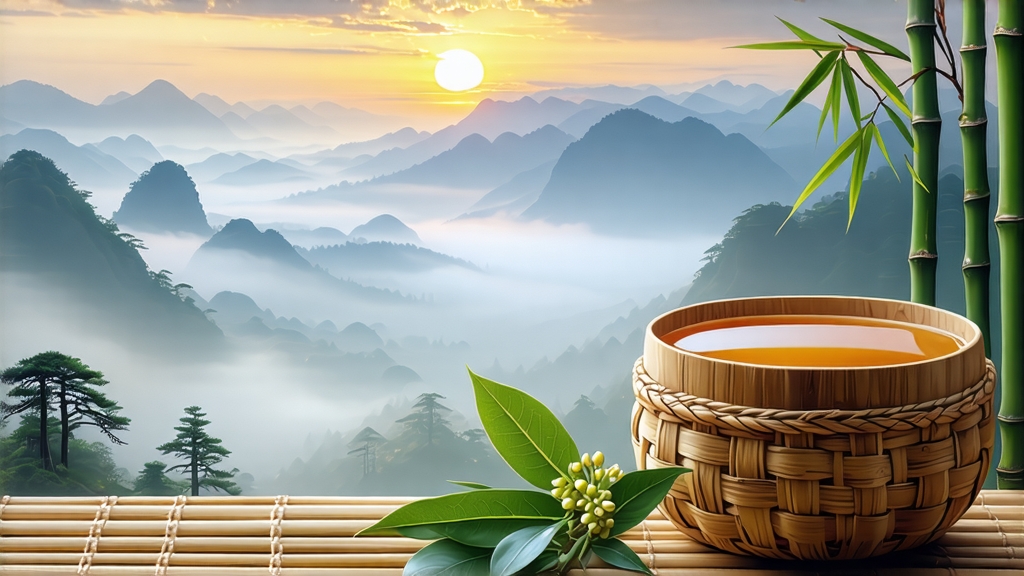
Tucked above the Sichuan basin, where the Min River carves clouds into the slopes of Mount Meng, a tea once reserved for Tang-dynasty emperors still breathes. Meng Ding Huang Ya—literally “Yellow Bud from Meng Summit”—is the least-known yet most aristocratic child of China’s six great tea families. While green tea races for freshness and pu-erh courts time, this yellow tea chooses a middle path: it borrows spring’s urgency, then slows the clock with a confidential yellowing that turns leaf sugars into liquid gold. To the international palate it offers the clarity of a green tea without the edge, the depth of a light oolong without the perfume, and the rounded sweetness of a white tea without languor. Understanding it is like learning a musical mode between major and minor: once you hear the note, other teas seem slightly out of tune.
History: from altar to exile
Buddhist monks planted the first tea gardens on Meng Ding as early as 53 BCE, gifting the tender buds to Han-dynasty officials who carried them to Chang’an along the ancient plank roads. By Tang times (618-907 CE) the tea had become imperial tribute; Song chronicles record a special “Yellow Bud Bureau” whose only duty was to guard the sealed jars during the 1,400-kilometer journey to Kaifeng. The Ming dynasty shifted the capital northward, transport routes changed, and Meng Ding Huang Ya slipped into obscurity—so completely that when the Qing court re-discovered it in 1724 the local gazetteer called the tea “extinct.” Villagers, however, had never stopped making small batches for family altars and dowries. Thus the varietal survived in the kitchens of Ya’an farmers rather than the imperial storehouses of Beijing, a genetic and cultural refugee waiting for the world to remember.
Micro-terroir: where cloud roots drink stone
Meng Ding is not a single peak but a granite spine rising from 800 m to 1,450 m within the larger Erlang mountain system. The area records 280 foggy days a year; ultraviolet light diffused through moisture forces the tea bush to synthesize more theanine and fewer bitter catechins. Soils are young, acidic sandy loam rich in quartz and biotite mica—minerals that lend a subtle electric snap to the finish. Day-night temperature differentials can exceed 15 °C in early April, concentrating amino acids during the slow nocturnal respiration of the leaf. The result is a bud so plump that locals call it “sparrow’s tongue,” downy yet translucent, smelling faintly of rain on hot slate even before it is picked.
Plucking: one dawn, one standard
The harvest window opens when five consecutive days remain above 12 °C but below 22 °C, usually between 1–10 April. Only the terminal bud and the first unfolding leaf (called yi ya yi ye) are taken, before 10 a.m. while dew still glitters. A seasoned picker can gather just 600 g fresh leaf in four hours—barely enough, after all processing loss, for one hundred grams of finished tea. The pluckers work in pairs: one clips the shoot with a copper fingernail guard to prevent bruising, the other catches it on a silk-lined bamboo tray. No plastic touches the leaf; even the baskets are woven from Meng bamboo whose phenolic resins act as a natural antimicrobial.
Craft: the confidential yellowing
Yellow tea’s identity rests on men huang—“sealed yellowing”—a step unknown to green, black, or oolong. After a brief outdoor withering of 30 minutes, the buds are wok-fired at 180 °C for three minutes to arrest oxidation enzymes. While still at 60 °C internal temperature they are wrapped in thick parchment paper and placed inside a bamboo box lined with wet cotton. The box is slid into a charcoal-warmed closet kept at 35 °C and 75 % humidity for four hours. During this sauna the leaf chlorophyll degrades into pheophytin, catechins dimerize into theaflavins, and a Maillard veil of maltol and furaneol forms. The process is repeated three times—wrap, rest, unwrap, re-fire—each cycle lowering temperature and humidity until the leaf aroma shifts from fresh pea to toasted pumpkin seed. Finally the leaves are baked over a lychee-wood charcoal bed at 70 °C for 90 minutes, reducing moisture